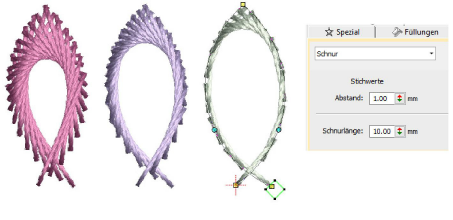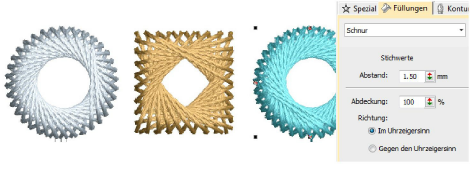String Stitch has its origins in India where it is known as ‘Paghadi’. Sie wird häufig benutzt, um kleine Spiegel in filigranen Stoffdesigns zu befestigen. String Stitch mimics the overlapping ‘string art’ of Paghadi stitching. It too can be used to secure mirrors or sequins. Or it can be used for decorative effects such filling leaf-like shapes with elongated stitching. It comes in two forms – outlines and fills – and can be applied to open or closed shapes.

Most String stitch effects can be achieved by quite simple means. Since stitch angles have no effect, you can digitize most shapes with simple tools such as Run or Komplexer Füllstich. Schnur-Kontur bietet Abstand- und Schnurlängen-Einstellungen, um Konturdicke und -dichte zu kontrollieren. Reversing entry and exit points will also affect the direction of stitch overlaps.

Schnur-Füllung bietet eine Abstandseinstellung zur Kontrolle der Stichdichte. Die Dicke wird von der Form bestimmt. Try using it with both closed objects and objects with holes such as Ring objects. Direction of stitch overlaps is controlled by the Direction setting.

The Coverage setting can be used create partial covers such as the ones below. Control orientation either via the Direction setting or by changing entry/exit points.
